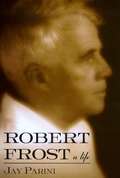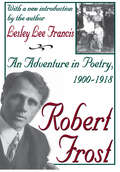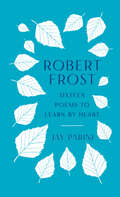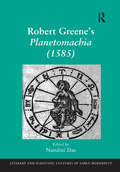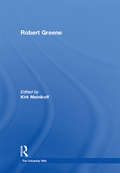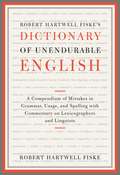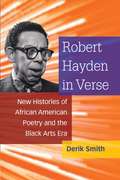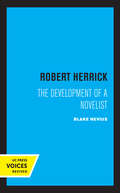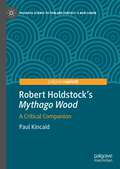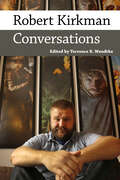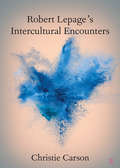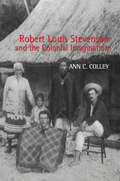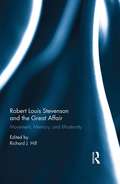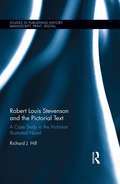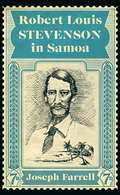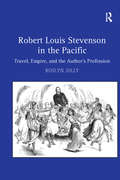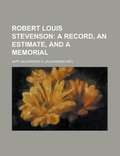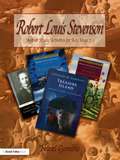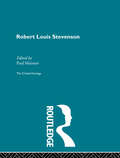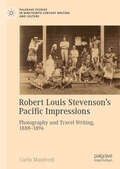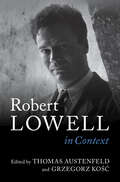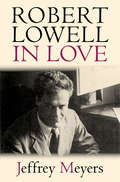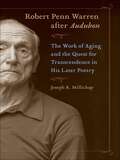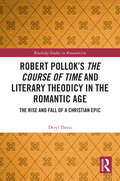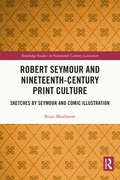- Table View
- List View
Robert Frost: A Life
by Jay Parini"I have tried to understand how Frost got from day to day and from poem to poem, tracing his rich, always developing, intellectual and artistic life over many decades. My intention was not to supplant or overtake previous biographers and critics but merely to add a significant layer. I can say without fear of exaggeration that this life of Frost was a labor of love. It is one of the few books I have ever finished with deep reluctance."
Robert Frost: An Adventure in Poetry, 1900-1918
by Lesley Lee FrancisIn this volume, Lesley Lee Francis, granddaughter of Robert Frost, brings to life the Frost family's idyllic early years. Through their own words, we enter the daily lives of Robert, known as RF to his family and friends, his wife, Elinor, and their four children, Lesley, Carol, Irma, and Marjorie. The result is a meticulously researched and beautifully written evocation of a fleeting chapter in the life of a literary family.Taught at home by their father and mother, the Frost children received a remarkable education. Reared on poetry, nurtured on the world of the imagination, and instructed in the art of direct observation, the children produced an exceptional body of writing and artwork in the years between 1905 and 1915. Drawing upon previously unexamined journals, notebooks, letters, and the little magazine entitled The Bouquet produced by the Frost children and their friends, Francis shows how the genius of Frost was enriched by his interactions with his children. Francis depicts her grandfather as a generous, devoted, and playful man with a striking ability to communicate with his children and grandchildren. She traces the family's adventures from their farm years in New Hampshire through their nearly three years in England. This enchanting evocation of the Frost family's life together makes more poignant the unforeseen personal tragedies that would befall its members in later years.
Robert Frost: Sixteen Poems to Learn by Heart
by Robert Frost Jay PariniCelebrate Robert Frost's 150th birthday with a deluxe keepsake edition featuring 16 of his greatest poems—with brilliant essays highlighting his special genius and the power of memorization to unlock the magic of his languageDuring a public reading Robert Frost was once asked why he so frequently recited his poems from memory. With typical wit, he replied: &“If they won&’t stick to me, I won&’t stick to them.&” Remarkably among the modern poets, his poems &“stick&” to the reader: "Mending Wall," with its famous invocation of the rural maxim "Good fences make good neighbors""The Road Not Taken," about the beguiling possibilities of life"Birches," which reminds us that "One could do worse than be a swinger of birches"Stopping by Woods on a Snowy Evening," with its unforgettable final line: "And miles to go before I sleep."Here, poet and Frost biographer Jay Parini presents these and 12 other Frost poems to learn by heart. In short accompanying commentaries, Parini illuminates the stylistic and imaginative features of each of the poems, drawing in biographical material from Frost&’s life to provide further context. &“The goal of this little book is to encourage readers to slow down—to listen to Frost&’s words and phrases, to locate their deepest rhythms, and hear the tune of each poem as it unfolds. . . . Memorizing a poem can teach us much about a poem&’s structure and argument, and about the resonance of particular words. And best of all, memorization makes a poem part of our inner lives. Once committed to memory, a poem is available to us for recall at any time—and the occasions for remembering it will make themselves known to us. It isn&’t something we have to work at.&” Anyone who has read and loved Frost&’s poetry will want to own and treasure this little gift edition. Those reading Frost for the first time or those wishing to become better acquainted with one of America&’s greatest poets will not find a better, more insightful guide than Jay Parini.
Robert Greene's Planetomachia (Literary and Scientific Cultures of Early Modernity)
by Nandini DasWhen Planetomachia was published in 1585, Greene himself-always the best advertiser of his own books-promised his readers a perfectly balanced diet of edification and entertainment. He described his newest offering as an astronomical discourse on the nature and influence of the planets interlaced with 'pleasant and tragical histories,' which one could ostensibly use as a manual to identify various planetary influences on 'natural constitution.' In this first complete critical edition, Nandini Das presents Planetomachia as a complex hybrid which is eminently a product of its times, exploring how the two very different intellectual and cultural spheres of Humanist scholarship and Renaissance popular print engage in an intriguing, albeit uneasy, dialogue to produce this unique work of prose fiction. The volume gives a clear sense, afforded by no other existing edition, of the intellectual climate which shaped this text. It offers substantial introductory material (on biographical, literary and scientific contexts) and extensive annotation identifying Greene's allusions and elucidating his vocabulary. It also includes translations and extracts from significant sources, along with a bibliography of relevant primary texts and critical work on Greene generally and on Planetomachia in particular.
Robert Greene: Essays On England's First Notorious Professional Writer (The University Wits)
by Kirk MelnikoffWhile Robert Greene was the most prolific and perhaps the most notorious professional writer in Elizabethan England, he continues to be best known for his 1592 quip comparing Shakespeare to "an upstart crow." In his short twelve-year career, Greene wrote dozens of popular pamphlets in a variety of genres and numerous professional plays. At his premature death in 1592, he was a bonafide London celebrity, simultaneously maligned as Grub-Street profligate and celebrated as literary prodigy. The present volume constitutes the first collection of Greene's reception both in the early modern period and in our present era, offering in its poems, prose passages, essays, and chapters that which is most singular among what has been written about Greene and his work. It also includes a complete list of Greene's contemporary reception until 1640. Kirk Melnikoff's wide-ranging and revisionist introduction organizes this reception generically while at the same time situating it in the context of recent critical methodologies.
Robert Hartwell Fiske's Dictionary of Unendurable English: A Compendium of Mistakes in Grammar, Usage, and Spelling with commentary on lexicographers and linguists
by Robert Hartwell FiskeRobert Hartwell Fiske aims to eliminate laxity in language today by way of this witty and engaging reference. Fiske rails against "laxicographers and ding-a-linguists" who, with their misguided thinking, actually promote the dissolution of the English language. He also illustrates why dictionaries don't always provide the correct meaning or usage of a word. With concise instruction and numerous examples of misused words, Fiske makes it easier than ever to learn from others' mistakes. This comprehensive dictionary of common misusages lays bare the mistakes we all make every day. Robert Hartwell Fiske, the grumbling grammarian of our time, shows you the definitive right way and wrong way to use language--and illustrates why dictionaries don't always provide the correct meaning or usage of a word.
Robert Hayden in Verse: New Histories of African American Poetry and the Black Arts Era
by Derik SmithThis book sheds new light on the work of Robert Hayden (1913–80) in response to changing literary scholarship. While Hayden’s poetry often reflected aspects of the African American experience, he resisted attempts to categorize his poetry in racial terms. This fresh appreciation of Hayden’s work recontextualizes his achievements against the backdrop of the Black Arts Movement and traces his influence on contemporary African American poets. Placing Hayden at the heart of a history of African American poetry and culture spanning the Harlem Renaissance to the Hip-Hop era, the book explains why Hayden is now a canonical figure in 20th-century American literature. In deep readings that focus on Hayden’s religiousness, class consciousness, and historical vision, author Derik Smith inverts earlier scholarly accounts that figure Hayden as an outsider at odds with the militancy of the Black Arts movement. Robert Hayden in Verse offers detailed descriptions of the poet’s vigorous contributions to 1960s discourse about art, modernity, and blackness to show that the poet was, in fact, an earnest participant in Black Arts-era political and aesthetic debates.
Robert Herrick: The Development of a Novelist
by Blake NeviusThis title is part of UC Press's Voices Revived program, which commemorates University of California Press’s mission to seek out and cultivate the brightest minds and give them voice, reach, and impact. Drawing on a backlist dating to 1893, Voices Revived makes high-quality, peer-reviewed scholarship accessible once again using print-on-demand technology. This title was originally published in 1962.
Robert Holdstock’s Mythago Wood: A Critical Companion (Palgrave Science Fiction and Fantasy: A New Canon)
by Paul KincaidThis book is a detailed examination of one of the most important works of fantasy literature from the twentieth century. It goes through Mythago Wood by Robert Holdstock considering how it engages with war on a personal and family level, how it plays with ideas of time as something fluid and disturbing, and how it presents mythology as something crude and dangerous. The book places Mythago Wood in the context of Holdstock’s other works, noting in part how complex ideas of time have been a consistent element in his fiction. The book also briefly examines how the themes laid out in Mythago Wood are carried through into later books in the sequence as well as the Merlin Codex
Robert Kirkman: Conversations (Conversations with Comic Artists Series)
by Terrence R. WandtkeRobert Kirkman (b. 1978) is probably best known as the creator of The Walking Dead. The comic book and its television adaptation have reinvented the zombie horror story, transforming it from cult curiosity and parody to mainstream popularity and critical acclaim. In some ways, this would be enough to justify this career-spanning collection of interviews. Yet Kirkman represents much more than this single comic book title.Kirkman’s story is a fanboy’s dream that begins with him financing his irreverent, independent comic book Battle Pope with credit cards. After writing major titles with Marvel comics (Spider-Man, Captain America, and X-Men), Kirkman rejected companies like DC and Marvel and publicly advocated for creator ownership as the future of the comics industry. As a partner at Image, Kirkman wrote not only The Walking Dead but also Invincible, a radical reinvention of the superhero genre. Robert Kirkman: Conversations gives insight to his journey and explores technique, creativity, collaboration, and the business of comics as a multimedia phenomenon. For instance, while continuing to write genre-based comics in titles like Outcast and Oblivion Song, Kirkman explains his writerly bias for complex characters over traditional plot development. As a fan-turned-creator, Kirkman reveals a creator’s complex relationship with fans in a comic-con era that breaks down the consumer/producer dichotomy. And after rejecting company-ownership practices, Kirkman articulates a vision of the creator-ownership model and his goal of organic creativity at Skybound, his multimedia company. While Stan Lee was the most prominent comic book everyman of the previous era of comics production, Kirkman is the most prominent comic book everyman of this dynamic, evolving new era.
Robert Lepage's Intercultural Encounters (Elements in Shakespeare Performance)
by Christie CarsonThis study returns to the origins of Robert Lepage's directorial work and his first cross-cultural interaction with a Shakespearean text to provide some background for his later work. This early work is situated within the political and social context of Quebec and Canada in the 1980s. Constitutional wrangling and government policies of bilingualism, biculturalism and multiculturalism all had a profound impact on this director, helping to forge his priorities and working methods. In 2018 two of Lepage's productions were cancelled due to concerns about cultural appropriation. Lepage responded by stating his view that the artist is as above the concerns of political correctness. While this approach was deemed acceptable in the 1980s, this study looks at the dangers posed by approaching cross-cultural creation from this standpoint in the 21st century.
Robert Louis Stevenson and the Colonial Imagination
by Ann C. ColleyIn her distinguished and hauntingly rendered book, Ann C. Colley provides a fresh insight into Stevenson's multi-voiced South Seas fiction, as well as into the particulars and complications of living within a newly established site of Empire. Bringing to light information from the archives of the London Missionary Society and from other sources, such as the Royal Geographical Society (London), the Writers' Museum (Edinburgh), the Beinecke Library (Yale University), and the Huntington Library (San Marino, California), Colley examines the intricate nature of Robert Louis Stevenson's relation to imperialism. In particular, she investigates Stevenson's complex relationship to the missionary culture that surrounded him during the last six years of his life (1888-1894), revealing hitherto unscouted routes by which to understand Stevenson's experiences while he was cruising among the South Sea islands, and later while he was a resident colonial in Samoa. Beginning with a history of the missionaries in the Pacific that reveals Stevenson's criticism of, yet ultimate support for, their work, and demonstrates how these attitudes helped shape his South Sea fiction, Robert Louis Stevenson and the Colonial Imagination constitutes a major work of reconstruction from archival sources. Subsequent chapters focus on Stevenson's struggles with personal and cultural identity in the South Seas, and his interest in photography, panoramas, and magic lantern shows, revealing Stevenson's sensitivity to the ways light plays upon darkness to create meaning. In addition, Stevenson's serious commitment to political issues and his thoughts about power and nationhood are explored. Finally, Stevenson's recollections of his childhood are engaged not only to suggest an unacknowledged source (the juvenile missionary magazines) for A Child's Garden of Verses, but also to illuminate the generous reach of his imagination that exceeds the formulae of the missionary culture and the boundaries of the colonial construct.
Robert Louis Stevenson and the Great Affair: Movement, Memory and Modernity
by Richard J. HillIn his travel narrative Travels with a Donkey in the Cevennes (1879), Robert Louis Stevenson declares, "I travel not to go anywhere, but to go. I travel for travel's sake. The great affair is to move. " Taking up the concepts of time, place, and memory, the contributors to this collection explore in what ways the dynamic view of life suggested by this quotation permeates Stevenson's work. The essays adopt a wide variety of critical approaches, including post-colonial theory, post-structuralism, new historicism, art history, and philosophy, making use of the vast array of literary materials that Stevenson left across a global journey that began in Scotland in 1850 and ended in Samoa in 1894. These range from travel journals, letters, and classic literary staples such as Treasure Island and The Strange Case of Dr. Jekyll and Mr. Hyde, to rarely read masterpieces such as The Master of Ballantrae or The Ebb-Tide. While much recent scholarship on Stevenson foregrounds geography, the present volume also examines the theme of movement across memory, time, and generic boundaries. Taken together, the essays offer a view of Stevenson that demonstrates how the protean nature of his literary output reflects the radical developments in science, technology, and culture that characterized the age in which he lived.
Robert Louis Stevenson and the Pictorial Text: A Case Study in the Victorian Illustrated Novel (Studies in Publishing History: Manuscript, Print, Digital)
by Richard J. HillRobert Louis Stevenson and the Pictorial Text explores the genesis, production and the critical appreciation of the illustrations to the fiction of Robert Louis Stevenson. Stevenson is one of the most copied and interpreted authors of the late nineteenth century, especially his novels Treasure Island and Strange Case of Dr Jekyll and Mr Hyde. These interpretations began with the illustration of his texts in their early editions, often with Stevenson’s express consent, and this book traces Stevenson’s understanding and critical responses to the artists employed to illustrate his texts. In doing so, it attempts to position Stevenson as an important thinker and writer on the subject of illustrated literature, and on the marriage of literature and visual arts, at a moment preceding the dawn of cinema, and the rejection of such popular tropes by modernist writers of the early twentieth century.
Robert Louis Stevenson in Samoa
by Joseph FarrellShortlised for the Saltire Society Non Fiction Book of the Year Award Almost every adult and child is familiar with his Treasure Island, but few know that Robert Louis Stevenson lived out his last years on an equally remote island, which was squabbled over by colonial powers much as Captain Flint's treasure was contested by the mongrel crew of the Hispaniola.In 1890 Stevenson settled in Upolu, an island in Samoa, after two years sailing round the South Pacific. He was given a Samoan name and became a fierce critic of the interference of Germany, Britain and the U.S.A. in Samoan affairs - a stance that earned him Oscar Wilde's sneers, and brought him into conflict with the Colonial Office, who regarded him as a menace and even threatened him with expulsion from the island.Joseph Farrell's pioneering study of Stevenson's twilight years stands apart from previous biographies by giving as much weight to the Samoa and the Samoans - their culture, their manners, their history - as to the life and work of the man himself. For it is only by examining the full complexity of Samoa and the political situation it faced as the nineteenth century gave way to the twentieth, that Stevenson's lasting and generous contribution to its cause can be appreciated.
Robert Louis Stevenson in the Pacific: Travel, Empire, and the Author's Profession
by Roslyn JollyRobert Louis Stevenson's departure from Europe in 1887 coincided with a vocational crisis prompted by his father's death. Impatient with his established identity as a writer, Stevenson was eager to explore different ways of writing, at the same time that living in the Pacific stimulated a range of latent intellectual and political interests. Roslyn Jolly examines the crucial period from 1887 to 1894, focusing on the self-transformation wrought in Stevenson's Pacific travel-writing and political texts. Jolly shows how Stevenson's desire to understand unfamiliar Polynesian and Micronesian cultures, and to record and intervene in the politics of Samoa, gave him opportunities to use his legal education, pursue his interest in historiography, and experiment with anthropology and journalism. Thus as his geographical and cultural horizons expanded, Stevenson's professional sphere enlarged as well, stretching the category of authorship in which his successes as a novelist had placed him. Rather than enhancing his stature as a popular writer, however, Stevenson's experiments with new styles and genres, and the Pacific subject matter of his later works, were resisted by his readers. Jolly's analysis of contemporary responses to Stevenson's writing, gleaned from an extensive collection of reviews, many of which are not readily available, provides fascinating insights into the interests, obsessions, and resistances of Victorian readers. As Stevenson sought to escape the vocational straightjacket that confined him, his readers just as strenuously expressed their loyalty to outmoded images of Stevenson the author, and their distrust of the new guises in which he presented himself.
Robert Louis Stevenson: A Record, an Estimate, and a Memorial
by Alexander H. JappThe book has no illustrations or index. Purchasers are entitled to a free trial membership in the General Books Club where they can select from more than a million books without charge. Subjects: History / General; Biography
Robert Louis Stevenson: Author Study Activities for Key Stage 2/Scottish P6-7
by Nikki GambleFirst Published in 2005. Routledge is an imprint of Taylor & Francis, an informa company.
Robert Louis Stevenson: The Critical Heritage (Critical Heritage Ser.)
by Paul MaixnerFirst Published in 1995. Routledge is an imprint of Taylor & Francis, an informa company.
Robert Louis Stevenson’s Pacific Impressions: Photography and Travel Writing, 1888–1894 (Palgrave Studies in Nineteenth-Century Writing and Culture)
by Carla ManfrediThis book tackles photography’s role during Robert Louis Stevenson’s travels throughout the Pacific Island region and is the first study of his family’s previously unpublished photographs. Cutting across disciplinary boundaries, the book integrates photographs with letters, non-fiction, and poetry, and includes much unpublished material. The original readings of photographs and non-fiction highlight Stevenson’s engagement with colonial ideology and reality and advance new arguments about Victorian travel, settlement, and colonialisms in the Pacific. Like the Stevensons, the book moves from the Marquesas to the atolls of the Gilbert Islands in Micronesia; from the Kingdom of Hawai‘i’s political ambitions to Samoan plantations and the Stevensons’ settlement at Vailima. Central to this study is the notion that Pacific history and Pacific Island cultures matter to the interpretation of Stevenson's work, and a rigorous historical and cultural contextualization ensures that local details structure literary and photographic interpretation. The book’s historical grounding is key to its insightful conclusions regarding travel, settlement, photography, and colonialism.
Robert Lowell In Context (Literature in Context)
by Thomas Austenfeld Grzegorz KośćRobert Lowell was one of the most influential American poets of the 20th century. This volume explores the various contexts of Lowell's life and work and evaluates his oeuvre from new perspectives. Individual chapters address his relation to the South, his religious evolution, aspects of his marriages and private life, his bipolar disorder seen through new theories of mental illness, his work as a letter writer and a connoisseur of art and photography. The book also introduces new parameters for a contemporary study of Lowell, commenting on current debates about race and privilege, feminism, ecoconsciousness, his engagement with the natural environment as well as his friendships with Randall Jarrell and Robert Penn Warren.
Robert Lowell in Love
by Jeffrey MeyersRobert Lowell was known not only as a great poet but also as a writer whose devotion to his art came at a tremendous personal cost. In this book, his third on Robert Lowell, Jeffrey Meyers examines the poet’s impassioned, troubled relationships with the key women in his life: his mother, Charlotte Winslow Lowell; his three wives—Jean Stafford, Elizabeth Hardwick, and Caroline Blackwood; nine of his many lovers; his close women friends—Mary McCarthy, Elizabeth Bishop, and Adrienne Rich; and his most talented students, Anne Sexton and Sylvia Plath. Lowell’s charismatic personality, compelling poetry, and literary fame attracted lovers and friends who were both frightened and excited by his aura of brilliance and danger. He loved the idea of falling in love, and in his recurring manic episodes he needed women at the center of his emotional and artistic life. Each affair became an intense dramatic episode. Though he idealized his loves and encouraged their talents, his frenetic affairs and tortured marriages were always conducted on his own terms. Robert Lowell in Love tells the story of the poet in the grip of love and gives voice to the women who loved him, inspired his poetry, and suffered along with him.
Robert Penn Warren after Audubon: The Work of Aging and the Quest for Transcendence in His Later Poetry (Southern Literary Studies)
by Joseph R. MillichapDespite nearly universal critical acclaim for Robert Penn Warren's later poetry, much about this large body of work remains unexplored, especially the psychological sources of these poems' remarkable energy. In this groundbreaking work, Warren scholar Joseph R. Millichap takes advantage of current research on developmental psychology, gerontology, and end-of-life studies to offer provocative new readings of Warren's later poems, which he defines as those published after Audubon: A Vision (1969). In these often intricate poems, Millichap sees something like an autobiographical epic focused on the process of aging, the inevitability of death, and the possibility of transcendence. Thus Warren's later poetry reviews an individual life seen whole, contemplates mortality and dissolution, and aspires to the literary sublime.Millichap locates the beginning of Warren's late period in the extraordinary collection Or Else: Poem/Poems 1968--1974, basing his contention on the book's complex, indeed obsessive sequencing of new, previously published, and previously collected poems unified by themes of time, memory, age, and death. Millichap offers innovative readings of Or Else and Warren's five other late gatherings of poems -- Can I See Arcturus from Where I Stand?: Poems 1975; Now and Then: Poems 1976--1978, winner of the Pulitzer Prize; Being Here: Poetry 1977--1980; Rumor Verified: Poems 1979--1980; and Altitudes and Extensions 1980--1984. Among the autobiographical elements Millichap brings into his careful readings are Warren's loneliness in these later years, especially after the deaths of family members and friends; his alternating feelings of personal satisfaction and emptiness toward his literary achievements; and his sense of the power, and at times the impotence, of memory. Millichap's analysis explores how Warren often returned to images and themes of his earlier poems, especially those involving youth and midlife, with the new perspective given by advancing age and time's passage. Millichap also relates Warren's work to that of other poets who have dealt profoundly with memory and age, including Robert Frost, T. S. Eliot, Thomas Hardy, and, at times, John Milton, William Wordsworth, and the whole English and American nineteenth-century Romantic tradition.An epilogue traces Warren's changing reputation as a poet from the publication of his last volume in 1985 through his death in 1989 and the centennial of his birth in 2005, concluding persuasively that the finest of all of Warren's literary efforts can be found in his later poetry, concerned as it is with the work of aging and the quest for transcendence.
Robert Pollok’s The Course of Time and Literary Theodicy in the Romantic Age: The Rise and Fall of a Christian Epic (Routledge Studies in Romanticism)
by Deryl DavisThis book explores the contexts and reception history of Robert Pollok’s religious epic The Course of Time (1827), one of the best- selling long poems of the nineteenth century, which has been almost entirely forgotten today. Widely read in the United States and across the British Empire, the poem’s combination of evangelical Calvinism, High Romanticism, and native Scottishness proved irresistible to many readers. This monograph traces the poem’s origins as a defense of Biblical authority, divine providence, and religious orthodoxy (against figures like Byron and Joseph Priestley) and explores the reasons for The Course of Time’s enormous, decades- long popularity and later precipitous decline. A close reading of the poem and an examination of its reception history offers readers important insights into the dynamic relationship between religion and wider culture in the nineteenth century, the uses of literature as a vehicle for theological argument and theodicy, and the important but often overlooked role that religion played in literary— and, particularly, Scottish— Romanticism. This work will appeal to scholars of religious history, literary history, Evangelicalism, Romanticism, Scottish literature, and nineteenth- century culture.
Robert Seymour and Nineteenth-Century Print Culture: Sketches by Seymour and Comic Illustration (Routledge Studies in Nineteenth Century Literature)
by Brian MaidmentRobert Seymour and Nineteenth-Century Print Culture is the first book-length study of the original illustrator of Dickens’s Pickwick Papers. Discussion of the range and importance of Seymour’s work as a jobbing illustrator in the 1820s and 1830s is at the centre of the book. A bibliographical study of his prolific output of illustrations in many different print genres is combined with a wide-ranging account of his major publications. Seymour’s extended work for The Comic Magazine, New Readings of Old Authors and Humorous Sketches, all described in detail, are of particular importance in locating the dialogue between image and text at the moment when the Victorian illustrated novel was coming into being.
